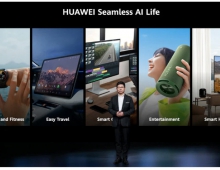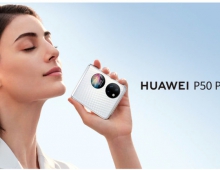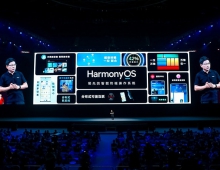
New Huawei Mate 9 Features Kirin 960, 5.9in FHD And Daydream VR
Huawei's Munich press event is over and the Chinese company unveiled its new flagship smartphone. The Mate 9 is featuring the latest generation HiSilicon Kirin SoC, a 5.96-inch Full-HD LED screen, dual Leica rear cameras, and Google DaydreamVR support. The new Kirin 960 SoC features ARM's new Cortex A73 CPU cores as well as the Mali-G71 graphics core. Huawei claims a +18% performance on the CPU and +180% on the GPU compared to the Kirin 950 in the Mate 8. The CPU uplift comes from the move to A73 cores over A72, and the GPU is from a doubling from MP4 to MP8 on the GPU along with a new GPU architecture, Bifrost. The CPU and GPU are connected with a new lower power interconnect, ARM's CCI-550, which is offering better efficiency and lower power than the previous generation CCI-400 series. For the Mate 9, Huawei is using TSMC's latest 16FFC process.
The Mate 9 has two cameras: a 20MP color camera and a 12MP black and white camera. The color camera will have optical image stabilization, while both with use up to 4K EIS via the internal DSP. With the dual camera design, Huawei is advertising effects such as post processing bokeh, and a 'hybrid 2x zoom' function which crops the 20MP image to a 12MP image to give the effect of zoom. Also into the Mate 9 inherits a series of effects from previous generations of flagships, such as light painting, but the new device will support Beauty Mode recording and slo-mo recording up to 240fps in 720p/HD mode. Both rear cameras are set at f/2.2, while the front camera is an 8MP with autofocus and f/1.9.

For the display, the Mate 9 is armed with a 5.96-inch Full-HD (1920x1080) LED display with a 1500:1 contrast ratio and a tailored '2.5D' glass finish. Color gamut is officially promoted as 96% NTSC.
Size |
|
Color |
Space Gray/Moonlight Silver/Champagne Gold/Mocha Brown/Ceramic White |
Display |
|
CPU |
HUAWEI Kirin 960, Octa-core CPU (4 x 2.4 GHz A73+ 4 x 1.8 GHz A53) + i6 co-processor, Mali-G71 MP8 |
Operation System |
Android 7.0 |
Memory |
MHA-L29: 4GB RAM + 64GB ROM, Micro SD card slot, support up to 256GB (uses SIM 2 slot) |
Network |
MHA-L29: SIM1:
SIM2:
MHA-L09:
|
GPS |
GPS/Glonass/Galileo/BDS |
Connectivity |
|
Sensors |
Fingerprint Sensor, G-Sensor, Gyroscope sensor, Compass, Ambient Light Sensor, Proximity sensor, Hall sensor, Barometer, IR |
Camera |
Main camera:
|
Audio |
|
Video |
|
EMUI |
EMUI 5.0 |
Battery |
4000mAh (Typical Value) |
Dual SIM Support |
|
NFC |
NFC supported |
The phone runs on the new EMUI 5.0, which features a new design philosophy centered on blue and white. The phone features a low blue light mode to aid using the device at night, and adjusts the software LUT and jacks up the greens to give a 'warmer' feel.
The Mate 9 will be available in two storage variants, either 64GB or 128GB of UFS 2.1, and each device has 4GB of DRAM. For additional storage, the dual Nano-SIM design will allow for a single memory card in the SIM 2 slot, supporting up to 256 GB. The phone's is powered by a 4000 mAh battery,
quoted as an 'all-day' battery. Huawei is implementing a 'SuperCharge' scheme using an internal controller in both the smartphone and the charging device itself. Rather than the 9V/2A fast charging combinations, Huawei says that SuperCharge uses on-the-fly dynamic voltage adjustments from 3.5-5V with 5A which can offer 3.5 hours of video playback on 10 minutes of charge. This charging mode can only occur with branded charging devices. Huawei says its fast-charging feature is offering 58% charge in the first 30 minutes.

Connectivity is via a USB 2.0 Type-C connection and Wi-Fi support is dual-band (2.4 GHz + 5 GHz) 802.11ac 2x2 with Wi-Fi Direct support. This module also supports Bluetooth 4.2 and Low Energy, and with this Huawei is also adding NFC.
Huawei is also promoting with the Mate 9 its onboard machine learning, designed to optimize the hardware as time goes on to reduce the impact of an aged system. Huawei says the system is "learning" which apps are frequently used and when, and then it optimizes the storage for contiguous loading and prioritizes DRAM accesses and CPU instructions for those apps. Actually that prioritization takes the form of core parking - all background apps are limited to one of the A53 cores on the SoC while the main app will have sole access to the other seven as needed.
Huawei will launch the Mate 9 in five colors (region dependent): space gray, moonlight silver, champagne gold, mocha brown and ceramic white.

The handset is launching alongside a lux variant, which has been given the clunky moniker of the Porsche Design Mate 9. This will be a limited edition device with boosted specs including 6GB of RAM, 256GB internal memory (compared to 64GB on the Mate 9), and a screen with 2K resolution. More notably, that handset's 5.5-inch display is curved. The Porsche Design handset costs €1,395 ($1,549). The regular Mate 9 is pricey too, costing €699 ($776). The latter device will launch in a number of European and Asian markets, but will also reach the US in the future.





















